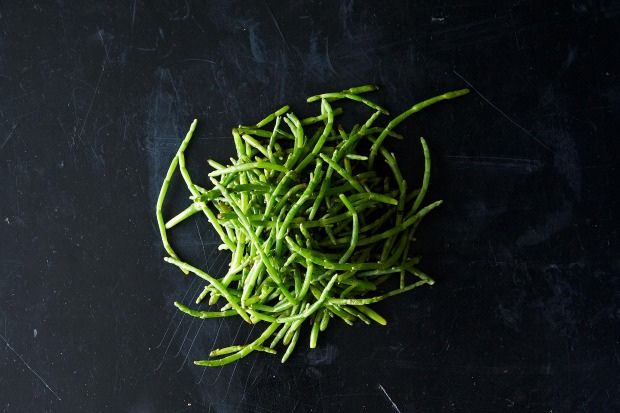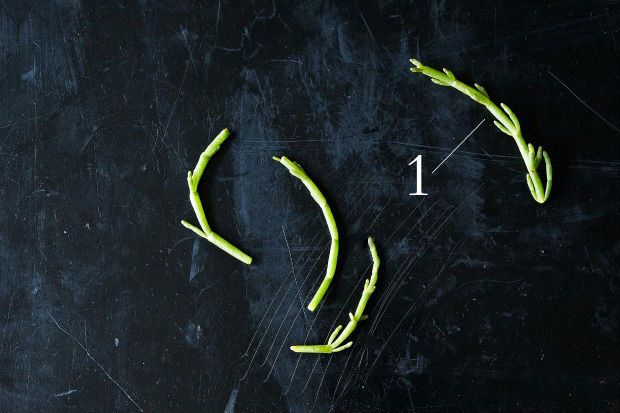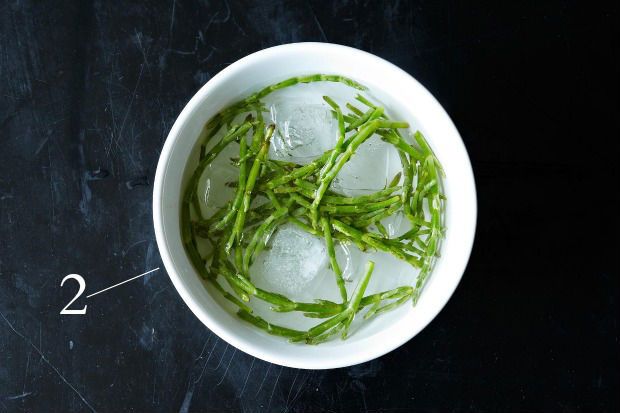Every week we get Down & Dirty, in which we break down our favorite unique seasonal fruits, vegetables, and more.
It looks like prehistoric seaweed, but salicornia is actually a salty succulent that wants to be worked into dinners all week long.

Like last week's burdock, salicornia doesn’t exactly look like dinner -- it looks more like something you’d stick in a fish tank rather than on your plate. Perhaps as a result of its unique looks, salicornia has benefited from a marketing campaign (sound familiar?) and is now also commonly referred to as sea beans -- along with a slew of other names like samphire, glasswort, pickleweed, and sea asparagus. The succulent has been making appearances for quite a while; it even shows up in King Lear: "Half-way down / Hangs one that gathers sampire; dreadful trade!" (Maybe Shakespeare wasn’t into foraging?)

Where to Find and What to Look For
Salicornia is often found along the seashore, so if you live near a coastal city, you can spot it at your farmers market during the summer. (Though it likes salty springs and marshes too, so you're not out of luck if you live inland.) You can also forage for it, order it online, or even grow it in your garden. In fact, according to Hank Shaw, it might actually prefer to be in your garden: “The plant loses a lot of its salty tang in sweet soil, but it grows much larger and fuller than it does in the salt marsh."
Choose sea beans that are small, firm, and bright green (1), and pass on any specimens that are limp or slimy. If you’re foraging, snap off small sections from the top of the plants -- it’s the most tender and best for the plant. By fall, salicornia can start to turn red, a sign that it has developed a tough central thread -- something you probably don't want to be eating. Stick to having them for dinner in the summer months.
More: Not sure where the nearest farmers market is? Find yours on Real Time Farms.

How to Store and Prep
Store your haul in the refrigerator, wrapped in a damp paper towel, and then in plastic; it stores well for about a week this way. If it starts to get a little limp, just refresh it in an ice water bath (2), which will come in handy for cooking, too. Since salicornia can be difficult to clean, Shaw recommends briefly blanching it for 30-90 seconds, and then shocking it in an ice bath to preserve color and stop the cooking.
How to Use
Salicornia shines as a garnish and in crunchy summer salads. You can also add it to a sandwich or a frittata, or use it where you would asparagus or green beans -- just be sure to reduce the salt in the recipe. That saltiness naturally pairs well with seafood, too, so try cooking fish or shellfish on a bed of salicornia (discard it after cooking). It can also be sautéed, stir-fried, or even deep-fried: just take care not to overcook it or it'll lose its signature crunch. Ready to work salicornia into your meals this week? Check out our ideas and be sure to let us know your tips!
Friday: Geoduck with Sea Beans and Porcini
Saturday: Black Roasted Cod with Sea Beans and Oysters
Sunday: Sea Bean Salad
Monday: Wild Salmon with Sea Beans
Tuesday: Shauna Ahern‘s Quick Pickled Sea Beans
Wednesday: Mussel and Sea Bean Salad
Thursday: Scallop Crudo with Sea Beans and Shiso
Photos by James Ransom

See what other Food52 readers are saying.